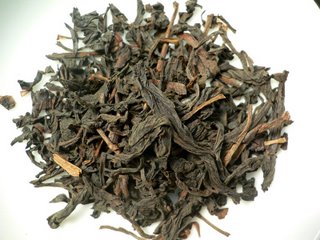 2 years old (the one I currently have listed in my selection).
2 years old (the one I currently have listed in my selection).  This Shui Xian is from 1997. I got it from the big box as it's still put aside and not packaged for sale, yet.
This Shui Xian is from 1997. I got it from the big box as it's still put aside and not packaged for sale, yet. And this one is 14 years old, from 1992. It's the oldest Shui Xian he has for sale as his 'Cha Wang', king of tea, the commonly used superlative.
And this one is 14 years old, from 1992. It's the oldest Shui Xian he has for sale as his 'Cha Wang', king of tea, the commonly used superlative.This is how they look when brewed. The youngest is on the left and the oldest on the right.

What's striking from the pictures (and it's the same in reality), is that you can't see any meanigful difference of age with the dry leaves or with the tea color. Why? Because even the young Shui Xian is heavily roasted: 7-8 hours at 140 degrees Celcius. This roasting gives it this charcoal look and dark red color. But if you can't see the differences, can you at least smell and taste them? The answer is yes. And that's where it becomes interesting to drink these 3 Wu Yi Shui Xian from the same Taiwanese roaster. This is a good study of how traditional Oolong (well fermented at 30-40%) and then even more strongly roasted will evolve over time.
The younger Shui Xian displays the usual roasting characteristics: heavier fragrances like black chocolate, coffee, Macadamia nuts. The charcoal smell is strong in the pot of wet leaves, but doesn't impact the tea very much. The mouthfeel is full body, with bitterness turning mellow.
The 9 years old Shui Xian shows additional complexity and develops more old wood, forest smells. The roasting seemed lightest here. Mr. Wang told me that they roast the Shui Xian every year, but I guess that it must be lighter roasting once it has reached a certain level.
The 14 years old Shui Xian had yet another change in fragrance: this one actually reminded me of some Chinese wines like Maotai. It's not as obvious as from the old LiShan Oolong jar that smelled like Cognac (which I reported a few weeks ago), but the same postfermentation processes are at work here. And the taste continued to feel richer and softer than the young Shui Xian.
Roasted Oolongs are teas from the past. Maybe they'll soon become endangered species if the general public continues to drive the demand for always lighter, greener and higher altitude Oolongs. These modern Oolongs are often just Mao Cha, unfinished tea. In the past, the city tea merchants would buy Mao Cha from the farmers and add their own roasting recipe. This is what Mr. Wang is still doing. With modern Oolong, merchants and buyers can forego this step, but this comes at the price of freshness. Such 'greener' Oolong will only taste great and fresh for a limited time. Consumers are then chasing spring and winter harvests and pay extra for fast shipping.
Traditional roasted Oolong, on the hand, has much more staying power. The older it gets, the better it may actually taste if you know how to store it. It seems like there are 2 trends or even 2 philosophies:
- green oolong could represent our quest for 'youth', modern consumerism. It's the part of us that refuses to age, that wants the latest car or the latest fashion.
- traditional oolong then would stand for the value of 'maturity'. The inner value is more important. Looks are deceptive (as for these teas that all look alike). More important is what's been nurtured inside, what it had to endure and go through.
Maybe it's also why it's easier to fall in love with young and sexy Oolong, but that it takes a while to acquire the taste for traditional Oolong!...

Since such heavily roasted older Shui Xians are less known by the current tea public, I propose to give you the opportunity to discover them as a small set, like I did. This sampler set would include approximately 30 grams (more or less 1 ounce) of each the 2 years, 9 years and 14 years old Shui Xian. Total price: 18 USD (14,5 Euros), without transportation for 90 grams.







5 comments:
A very insightful article!
I am a big fan of Wuyi oolongs, especially the dark-roasted varieties with their 'slow-burning' warmth. You mentioned storage when aging them - what is the best way to store these teas to achieve the best aging results?
Tjok
Tjok,
It depends for how long how like to store them:
- for the long term (10-20-30 years) you better use a glazed jar with rough clay. This will enable just enough postfermentation to happen to improve the tea and not too much to oxidise it.
- for the short to midterm, if you want to drink it within 1 or 2 years, then could use unglazed jars (like the Yixing jars I have in my selection). This is especially true if the tea has just been roasted and needs to rest and get rid of the roasting smells. Once you feel they are sufficiently cooled down you can put them in glazed jar.
Hello Stephane,
Do ageable oolongs have to be highly or heavily fired? Can the "lighter" fired one be aged long term (10-20-30 years)? I mean lighter by the fact that the tea still has some hint of greeness, but it's quite roasty too already.
Thanks,
Phyll
Josslucio,
Actually, my blog is the best mail-order source that I know. You can just send me an email at: stephane_erler@yahoo.com
Thanks for your interest!
Post a Comment